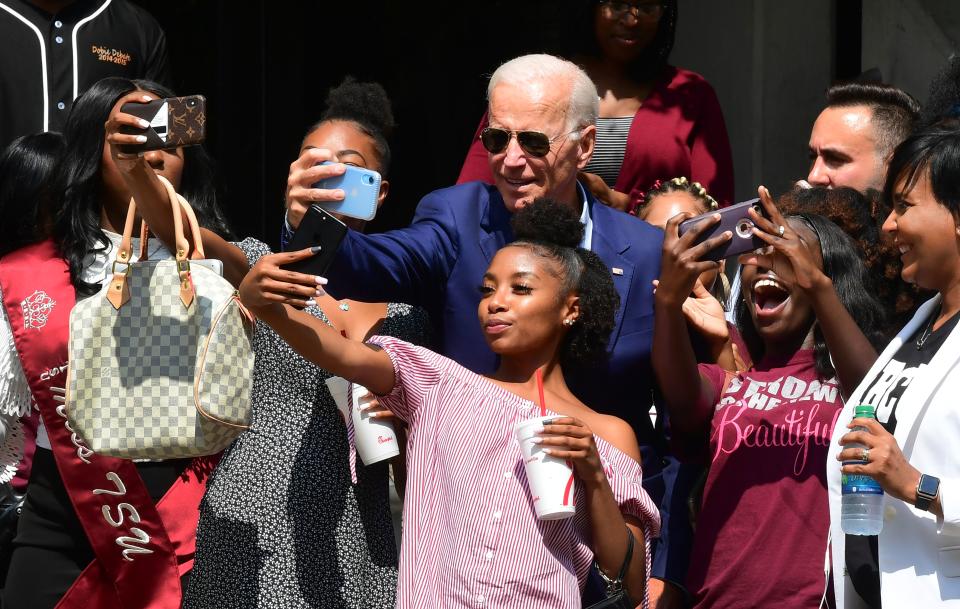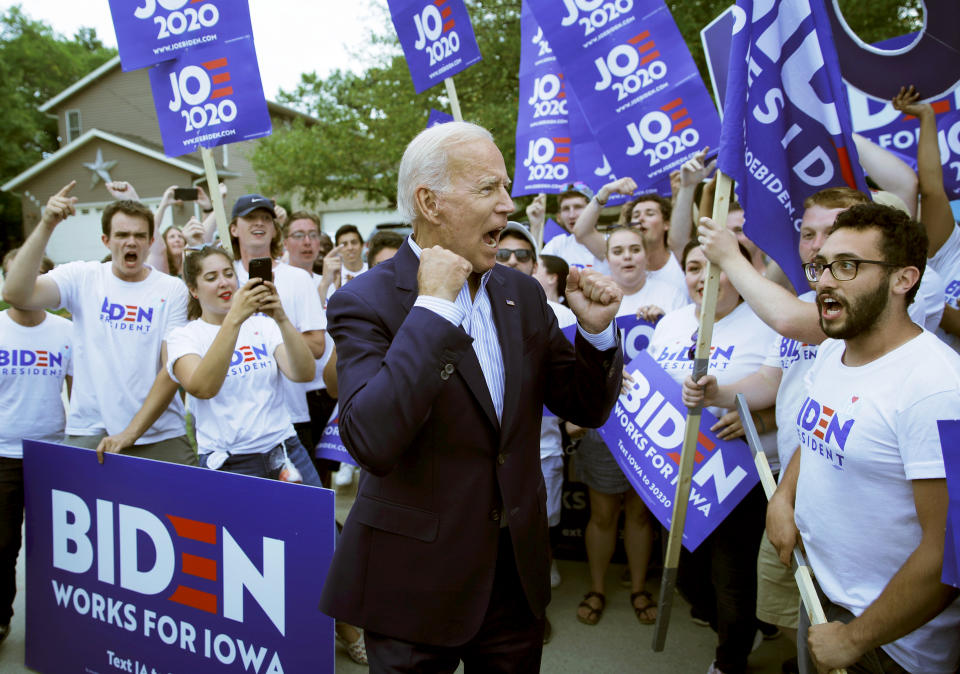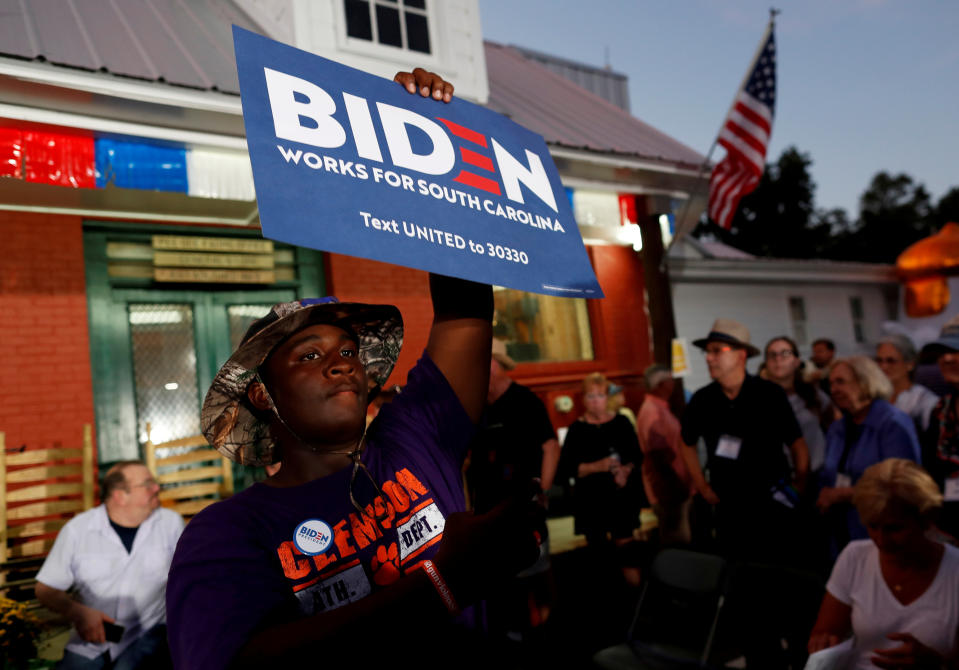The Biden campaign may have a youth vote problem. Here's how they're trying to fix it.
WASHINGTON — There aren’t many national polls in which former Vice President Joe Biden is in danger of being eclipsed by entrepreneur Andrew Yang. Except when it comes to support from young voters.
Indeed, the internet-friendly, dark-horse candidate recently netted 8 percent support from voters 18-34 years old according to a recent Quinnipiac poll — and Biden was only two points ahead. Both, however, were far behind Vermont Sen. Bernie Sanders and Massachusetts Sen. Elizabeth Warren, who netted 31 and 25 points respectively.
Young voters veering left in this pack of primary challengers is nothing new; back in June, polling of young voters showed Warren as their No. 1 pick, with Sanders following close behind. Biden tied for fourth place with California Sen. Kamala Harris.
Critics of youth turnout often harp on the fact that young voters don’t turn out. Their gripe has been grounded in some truth, but current trend lines reflect a far more motivated electorate. Millennial and Gen Z voters showed up in record numbers in the 2018 midterms, with a combined 30.6 million ballots, a quarter of midterm totals. While there’s not an abundance of polling on the predicted turnout of Gen Z and millennials in 2020 (though Pew estimates they’ll make up 10 percent of eligible voters), young voters have been keeping a close eye on the race.

The same Quinnipiac poll indicates that a combined 75 percent of 18- to 34-year-old respondents have been paying either “a lot” or “some” attention to the race, passing the combined enthusiasm for the next eldest subset of voters.
Young voters are on pace to be one of the largest new voting blocs and could prove make-or-break for campaigns looking to create considerable polling distance between their competitors, said youth engagement nonprofit Rock the Vote spokesman Andrew ieldman.
Feldman said it was engaging young voters in aggressive ways that gave Sanders an edge over former Secretary of State Hillary Clinton in 2016.
“Bernie had a very insurgent campaign,” Feldman told Yahoo News. “In large ways young people put him on the map. The campaign who pays attention this time around could see the same gains.”
But insurgency is built on, if anything, ideas. And the newest crop of young voters are motivated by bold and hyperliberal solutions to health care access, racism, income inequality and immigration. Campaigns not directly addressing these issues might render themselves unpopular said Abby Kiesa, director of impact at the Center for Information and Research on Civic Learning and Engagement (CIRCLE), an arm of Tufts University dedicated to studying the political life of young people in the U.S.

“If we see some differentiation between Biden and Warren and Sanders, it might very well be because of those issues and the importance that younger generations put on issues over party,” said Kiesa.
Young voters seem more attracted to progressive candidates who speak “really explicitly about racism and about inequality” said Kiesa, and often find themselves left out of mainstream political conversation “because in every election cycle we see that campaigns obviously target people who they think are going to vote and vote for them. And so that leaves a whole bunch of young people out.”
But the Biden campaign doesn’t find their own standing among young voters concerning, at least considering to their substantially higher national averages.
“We feel really good about what the average is, about the young voters that turn out to his events in the first four,” deputy campaign manager Pete Kavanaugh said, referring to Iowa, New Hampshire, Nevada and South Carolina. “I don’t think it’s any cause for concern. You’re always going to have some changes, obviously, across demographics, but we still think he appeals to young people.”
Kavanaugh added that their team made considerable efforts to focus on college campuses, and the campaign has positioned paid staff in early voting states to ensure that their youth mobilization results in high primary returns. According to Team Biden, Iowa’s youth reach director will have five more full-time campus organizers aim to expand Students for Biden across the state, and a key component of South Carolina’s youth vote director is to engage students at in-state historically black colleges and universities.

That centralized strategy is something the campaign believes was on full display at a recent stop at Texas Southern University, where Biden visited college-age voters, perhaps in hopes of making inroads with young black voters to match the support he enjoys among older black voters in the region. Boosting support from young black voters might take a little less effort than courting the voting bloc writ large; a Morning Consult poll shows that 30 percent of them support Biden — 20 percent above the all-around average.
“Are there going to be some variants in polling across ages and demographics? Sure, but I think we are making very concerted efforts to reach out to younger voters and I think we're beginning to see the fruits of that labor, especially, again, we're able to engage with students in a one-on-one setting,” Kavanaugh said.
Feldman noted that young-voter turnout will hinge largely on education, not engagement.
“We have seen that young voters are not apathetic,” he added, noting that campaigns might not find these young voters turning out at rallies, since many are in school. Instead, he urges that campaigns must meet young voters — and potential recruits — “in a space where they are every day, partnering with people that young people trust.”
But that’s only half the battle; the second, and perhaps bigger part of the equation, is moving affection to action. A lot of mobilization needs to take place in state youth organization, said Kiesa, who labeled such efforts as crucial, and in some 2018 midterm races, election-making.
According to CIRCLE data, the youth vote was “decisive” in pushing candidates to victory by the slimmest of margins in Wisconsin, Nevada and Montana. For example, young voters supported Wisconsin Democrat Tony Evers by a 23-point margin. Evers won the House seat over GOP incumbent Scott Walker by a mere 1.2 percentage point. Kiesa says turnout from under 30-voters cost Walker victory. CIRCLE also found that youth turnout was also higher by 33 percent “in the group of states with both a hot-button ballot issue and a competitive statewide race: Florida, Georgia, Arizona, Missouri, Montana and North Dakota.”
Young voters of color were even more crucial from county-by-county estimates.
“As we look, state by state, we see that the work being done on the ground to mobilize young people, young people themselves actually doing that work, can have a really big impact because of how young people vote in a certain location. And that — regardless of the size and the turnout — can have a significant effect,” Kiesa said.
In the end, Biden’s campaign knows it can’t afford to leave any group behind.
Kavanaugh says Biden will be “competing for every voter” in the first four primary states, and this priority is reflected in the campaign’s organization.
“We want to make sure we’re talking to everybody and we feel absolutely that is going to pay off,” said Kavanaugh. “Everyone is up for grabs.”
Download the Yahoo News app to customize your experience.
Read more from Yahoo News:
Kavanaugh book authors: 2020 Democrats had a 'rush to judgment' on impeachment after NYT op-ed
Russia carried out a 'stunning' breach of FBI communications system
Court revives suit alleging Fox News inflicted 'emotional torture' on Seth Rich family
After hours of questioning Lewandowski, Democrats finally land punches




